In previous graphics card performance evaluations shared by the editor, the GeForce GTX 1080 Ti was a highly prominent veteran. Although it has been released for six to seven years, its strength remains formidable, enough to rival entry-level models from the RTX 20 to RTX 40 series, including the GeForce RTX 4060.
However, most opponents previously ranked against the GeForce GTX 1080 Ti were from the NVIDIA camp. As the saying goes, ‘Each to their own,’ a portion of friends also prefer AMD graphics cards for their higher cost-effectiveness.
Therefore, let’s arrange a battle between the GeForce GTX 1080 Ti and the Radeon RX 7800 XT to assess how much performance improvement can be obtained by upgrading from the GeForce GTX 1080 Ti to the Radeon RX 7800 XT in gaming performance, for everyone’s reference.
01
Parameter Comparison of RX 7800 XT and GTX 1080 Ti
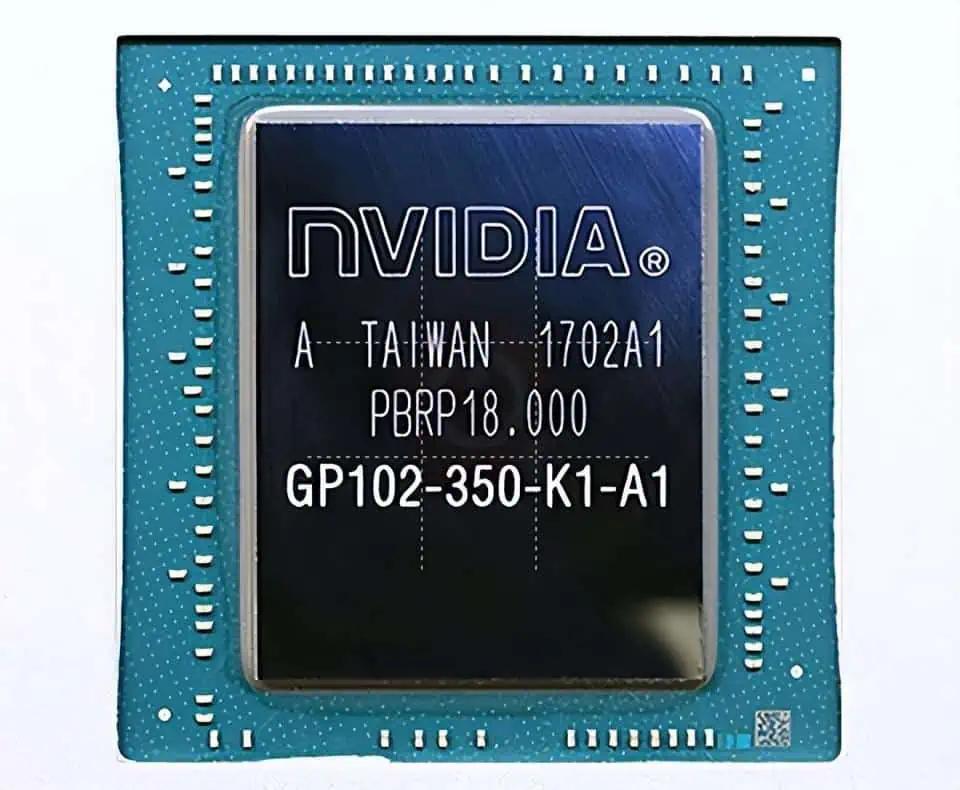
The GeForce GTX 1080 Ti was released on March 10, 2017, utilizing the GP102 GPU based on the Pascal architecture. It operates on a TSMC 16-nanometer process, featuring 3584 CUDA cores, 224 texture units, 88 rasterization units, 28 multi-unit streaming processors, and a 2.75MB L2 cache.
It has a base clock frequency of 1481MHz, a maximum boost clock frequency of 1572 MHz, and is equipped with 11GB of GDDR5X memory running at a speed of 11Gbps. The memory interface is 352 bits wide, providing a memory bandwidth of 484.4GB/s. The card’s FP32 performance reaches 11.34 TFLOPS, with a power consumption of 250W. The official suggested retail price upon release was $699.
The Radeon RX 7800 XT was released on August 25, 2023, based on the RDNA3 architecture and utilizing the Navi32 XT GPU. It operates on a TSMC 5-nanometer process, boasting 3840 shader units, 240 texture units, 96 rasterization units, 60 compute units, and 60 ray tracing units. It has a 4MB L2 cache and a 64MB L3 cache.
With a base clock frequency of 1800 MHz and a maximum boost clock frequency of 2430 MHz, it has 16GB of GDDR6 memory. The memory interface is 256 bits wide, delivering a memory speed of 19.4 Gbps and a memory bandwidth of 624GB/s. Its FP32 floating-point performance reaches 37.32 TFLOPS, drawing power at 263W. The suggested retail price stands at $499.
02
Benchmark Performance Comparison of RX 7800 XT and GTX 1080 Ti

Before officially entering the game-testing phase, let’s take a look at the benchmark scores of these two graphics cards.
In the 3DMark Time Spy Extreme platform, the GeForce GTX 1080 Ti scored 4469 points, while the Radeon RX 7800 XT scored 9387 points. Based on this calculation, the performance of the Radeon RX 7800 XT is approximately 2.1 times that of the GeForce GTX 1080 Ti.
However, this is solely a theoretical value. The ultimate gaming performance depends on various factors and there are many variables involved. So, how does the actual situation turn out in the end?
03
Main Configuration of RX 7800 XT and GTX 1080 Ti
- Processor: Core i9-13900K
- Motherboard: ASUS ROG Strix Z790-E Gaming
- Memory: G.SKILL Trident Z5 RGB 32GB DDR5 6000MHz
- Storage: Two Samsung 970 EVO M.2 2280 1TB SSDs
- Operating System: Windows 11
04
Game Performance Test of RX 7800 XT and GTX 1080 Ti
The following will separately test eight games, all using the highest 1440P graphics quality mode. In the series of pictures below, the left side represents the GeForce GTX 1080 Ti platform, and the right side represents the Radeon RX 7800 XT platform.
① The First Game is “Ruins 2”

On the GeForce GTX 1080 Ti platform, the average frame rate is 29 FPS, with a minimum instantaneous frame rate of 25 FPS, frame time of 36.2ms, CPU usage at 5%, power consumption at 43W, temperature at 35 degrees, memory usage of 13.3GB, GPU usage at 99%, VRAM usage of 6.4GB, power consumption of 226W, temperature at 57 degrees.
For the Radeon RX 7800 XT platform, the average frame rate is 64 FPS, with a minimum instantaneous frame rate of 59 FPS, frame time of 20.4ms, CPU usage at 12%, power consumption at 57W, temperature at 41 degrees, memory usage of 13.7GB, GPU usage at 100%, VRAM usage of 7.0GB, power consumption of 240W, temperature at 45 degrees.
In this game, the CPU usage on the Radeon RX 7800 XT platform is 7% higher than its competitor, approximately more than twice as much. The memory usage is higher by 0.4GB, with almost equal GPU usage, and a 0.6GB higher VRAM usage.
Regarding the average frame rate, the Radeon RX 7800 XT platform is 35 FPS higher than the GeForce GTX 1080 Ti platform, roughly 2.2 times more. The minimum instantaneous frame rate is 2.4 times that of its competitor, with the frame time approximately 56% of its competitor’s. It consumes 14W more power, yet maintains a temperature that is 12 degrees lower, showcasing a significant advantage.
② The Second Game is “Cyberpunk 2077”

On the GeForce GTX 1080 Ti platform, the average frame rate is 38 FPS, with a minimum instantaneous frame rate of 31 FPS, frame time of 24.9ms, CPU usage at 13%, power consumption at 63W, temperature at 45 degrees, memory usage of 12.0GB, GPU usage at 99%, VRAM usage of 6.0GB, power consumption of 247W, temperature at 62 degrees.
For the Radeon RX 7800 XT platform, the average frame rate is 76 FPS, with a minimum instantaneous frame rate of 68 FPS, frame time of 13.3ms, CPU usage at 25%, power consumption at 84W, temperature at 48 degrees, memory usage of 11.4GB, GPU usage at 99%, VRAM usage of 7.2GB, power consumption of 270W, temperature at 47 degrees.
In this game, the CPU usage on the Radeon RX 7800 XT platform is 12% higher than its competitor, almost twice as much. The memory usage is lower by 0.6GB, with equal GPU usage, and 1.2GB higher VRAM usage.
Regarding the average frame rate, the Radeon RX 7800 XT platform is 38 FPS higher than the GeForce GTX 1080 Ti platform, precisely 2.0 times more. The minimum instantaneous frame rate is 2.2 times that of its competitor, with the frame time approximately 53% of its competitor’s. It consumes 23W more power, yet maintains a temperature that is 15 degrees lower.
③ The Third Game is “Mind Killer 2”
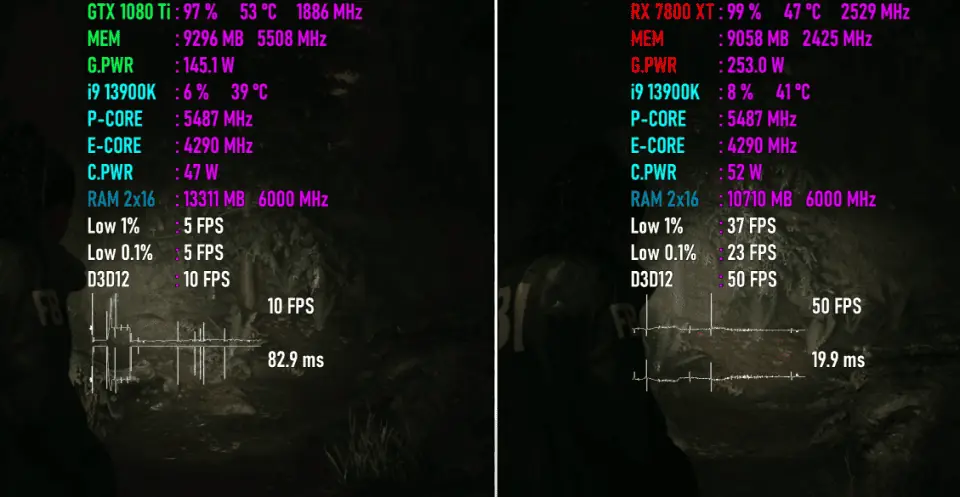
On the GeForce GTX 1080 Ti platform, the average frame rate is 10 FPS, with a minimum instantaneous frame rate of 5 FPS, frame time of 82.9ms, CPU usage at 6%, power consumption at 47W, temperature at 39 degrees, memory usage of 13.3GB, GPU usage at 97%, VRAM usage of 9.3GB, power consumption of 145W, temperature at 53 degrees.
For the Radeon RX 7800 XT platform, the average frame rate is 50 FPS, with a minimum instantaneous frame rate of 37 FPS, frame time of 19.9ms, CPU usage at 8%, power consumption at 52W, temperature at 41 degrees, memory usage of 10.7GB, GPU usage at 99%, VRAM usage of 9.1GB, power consumption of 253W, temperature at 47 degrees.
In this game, the CPU usage on the Radeon RX 7800 XT platform is only 2% higher than its competitor, with a small difference. The memory usage is lower by 2.6GB, GPU usage is higher by 2%, and VRAM usage is lower by 0.2GB.
Regarding the average frame rate, the GeForce GTX 1080 Ti platform struggles to run smoothly. The Radeon RX 7800 XT platform is 40 FPS higher than the GeForce GTX 1080 Ti platform, approximately 5.0 times more. The minimum instantaneous frame rate is over 8 times that of its competitor, with the frame time approximately 24% of its competitor’s. It consumes 108W more power while maintaining a temperature that is 6 degrees lower.
④ The Fourth Game is “Forza Horizon 5”
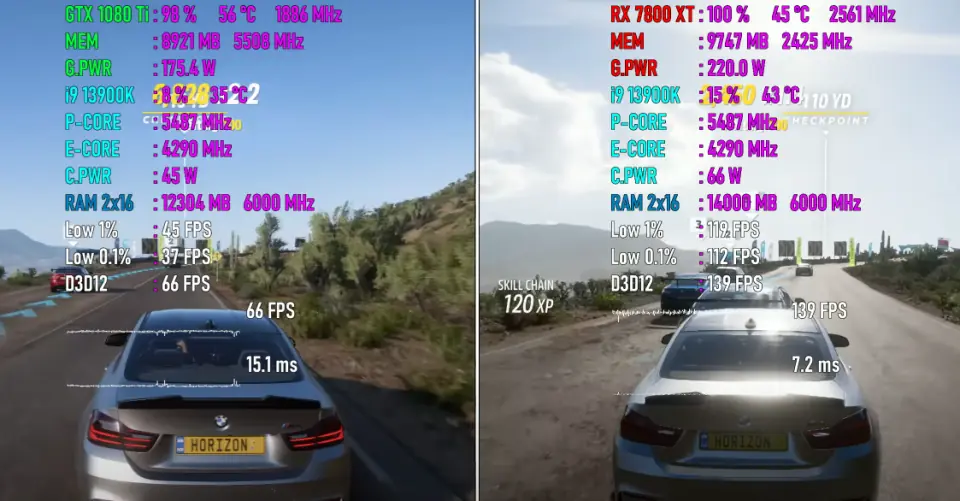
On the GeForce GTX 1080 Ti platform, the average frame rate is 66 FPS, with a minimum instantaneous frame rate of 45 FPS, frame time of 15.1ms, CPU usage at 8%, power consumption at 45W, temperature at 35 degrees, memory usage of 12.3GB, GPU usage at 98%, VRAM usage of 8.9GB, power consumption of 175W, temperature at 56 degrees.
For the Radeon RX 7800 XT platform, the average frame rate is 139 FPS, with a minimum instantaneous frame rate of 119 FPS, frame time of 7.2ms, CPU usage at 15%, power consumption at 66W, temperature at 43 degrees, memory usage of 14.0GB, GPU usage at 100%, VRAM usage of 9.7GB, power consumption of 220W, temperature at 45 degrees.
In this game, the CPU usage on the Radeon RX 7800 XT platform is 7% higher than its competitor, nearly twice as much. The memory usage is higher by 1.7GB, GPU usage is higher by 2%, and VRAM usage is higher by 0.8GB.
Regarding the average frame rate, the Radeon RX 7800 XT platform is 73 FPS higher than the GeForce GTX 1080 Ti platform, approximately 2.1 times more. The minimum instantaneous frame rate is 2.6 times that of its competitor, with the frame time approximately 48% of its competitor’s. It consumes 45W more power while maintaining a temperature that is 11 degrees lower.
⑤ The Fifth Game is “Red Dead Redemption 2”

On the GeForce GTX 1080 Ti platform, the average frame rate is 55 FPS, with a minimum instantaneous frame rate of 43 FPS, frame time of 17.9ms, CPU usage at 9%, power consumption at 50W, temperature at 35 degrees, memory usage of 12.7GB, GPU usage at 97%, VRAM usage of 5.1GB, power consumption of 247W, temperature at 61 degrees.
For the Radeon RX 7800 XT platform, the average frame rate is 103 FPS, with a minimum instantaneous frame rate of 79 FPS, frame time of 9.5ms, CPU usage at 30%, power consumption at 72W, temperature at 43 degrees, memory usage of 11.2GB, GPU usage at 98%, VRAM usage of 5.6GB, power consumption of 257W, temperature at 48 degrees.
In this game, the CPU usage on the Radeon RX 7800 XT platform is 21% higher than its competitor, nearly three times more. The memory usage is lower by 1.5GB, with almost equal GPU usage, and 0.5GB higher VRAM usage.
Regarding the average frame rate, the Radeon RX 7800 XT platform is 48 FPS higher than the GeForce GTX 1080 Ti platform, approximately 1.9 times more. The minimum instantaneous frame rate is 1.8 times that of its competitor, with the frame time approximately 53% of its competitor’s. It consumes 10W more power while maintaining a temperature that is 13 degrees lower.
⑥ The Sixth Game is “Hogwarts Legacy”
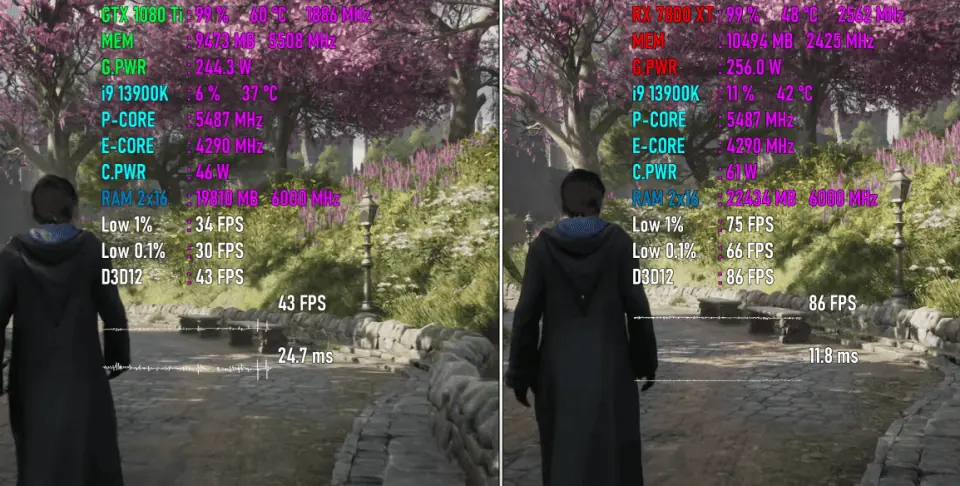
On the GeForce GTX 1080 Ti platform, the average frame rate is 43 FPS, with a minimum instantaneous frame rate of 34 FPS, frame time of 24.7ms, CPU usage at 6%, power consumption at 46W, temperature at 37 degrees, memory usage of 19.8GB, GPU usage at 99%, VRAM usage of 9.5GB, power consumption of 244W, temperature at 60 degrees.
For the Radeon RX 7800 XT platform, the average frame rate is 86 FPS, with a minimum instantaneous frame rate of 75 FPS, frame time of 11.8ms, CPU usage at 11%, power consumption at 61W, temperature at 42 degrees, memory usage of 22.4GB, GPU usage at 99%, VRAM usage of 10.5GB, power consumption of 256W, temperature at 48 degrees.
In this game, the CPU usage on the Radeon RX 7800 XT platform is 5% higher than its competitor, nearly twice as much. The memory usage is higher by 2.6GB, with equal GPU usage and 1GB higher VRAM usage.
Regarding the average frame rate, the Radeon RX 7800 XT platform is 43 FPS higher than the GeForce GTX 1080 Ti platform, precisely 2.0 times more. The minimum instantaneous frame rate is 2.2 times that of its competitor, with the frame time approximately 48% of its competitor’s. It consumes 12W more power while maintaining a temperature that is 12 degrees lower.
⑦ The Seventh Game is “Stellaris”
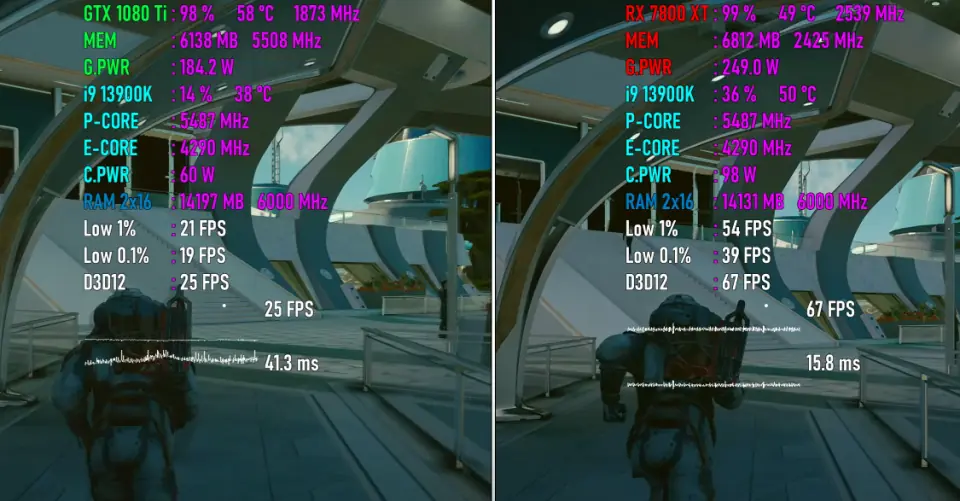
On the GeForce GTX 1080 Ti platform, the average frame rate is 25 FPS, with a minimum instantaneous frame rate of 21 FPS, frame time of 41.3ms, CPU usage at 14%, power consumption at 60W, temperature at 38 degrees, memory usage of 14.2GB, GPU usage at 98%, VRAM usage of 6.1GB, power consumption of 184W, temperature at 58 degrees.
For the Radeon RX 7800 XT platform, the average frame rate is 67 FPS, with a minimum instantaneous frame rate of 54 FPS, frame time of 15.8ms, CPU usage at 36%, power consumption at 98W, temperature at 50 degrees, memory usage of 14.1GB, GPU usage at 99%, VRAM usage of 6.8GB, power consumption of 249W, temperature at 49 degrees.
In this game, the GeForce GTX 1080 Ti platform falls slightly short of the minimum smooth-running threshold. The CPU usage on the Radeon RX 7800 XT platform is 22% higher than its competitor, more than twice as much. Memory usage and GPU usage are almost equal, with 0.7GB higher VRAM usage.
Regarding the average frame rate, the Radeon RX 7800 XT platform is 42 FPS higher than the GeForce GTX 1080 Ti platform, roughly 2.7 times more. The minimum instantaneous frame rate is 2.6 times that of its competitor, with the frame time approximately 38% of its competitor’s. It consumes 65W more power while maintaining a temperature that is 9 degrees lower.
⑧ The Eighth Game is “The Last of Us Part I”

On the GeForce GTX 1080 Ti platform, the average frame rate is 39 FPS, with a minimum instantaneous frame rate of 23 FPS, frame time of 26.3ms, CPU usage at 7%, power consumption at 47W, temperature at 34 degrees, memory usage of 16.3GB, GPU usage at 99%, VRAM usage of 10.0GB, power consumption of 255W, temperature at 58 degrees.
For the Radeon RX 7800 XT platform, the average frame rate is 92 FPS, with a minimum instantaneous frame rate of 70 FPS, frame time of 10.3ms, CPU usage at 22%, power consumption at 71W, temperature at 42 degrees, memory usage of 11.5GB, GPU usage at 100%, VRAM usage of 11.1GB, power consumption of 252W, temperature at 45 degrees.
In this game, the CPU usage on the Radeon RX 7800 XT platform is 15% higher than its competitor, more than twice as much. The memory usage is lower by 4.8GB, with almost equal GPU usage, and 1.1GB higher VRAM usage.
Regarding the average frame rate, the Radeon RX 7800 XT platform is 43 FPS higher than the GeForce GTX 1080 Ti platform, approximately 2.4 times more. The minimum instantaneous frame rate is 3 times that of its competitor, with the frame time approximately 39% of its competitor’s. It consumes 3W less power while maintaining a temperature that is 13 degrees lower.
05
Comparative Conclusion
Overall, compared to the GeForce GTX 1080 Ti, the Radeon RX 7800 XT has a significant advantage. In most games, it can deliver more than twice the processor performance of its competitor.
Excluding the lowest score and disregarding the performance of the third game, considering the combined scores of the other seven games, the overall performance of the Radeon RX 7800 XT is approximately 2.2 (2.19) times that of the GeForce GTX 1080 Ti. This conclusion is largely consistent with the earlier conclusion derived from the Time Spy Extreme platform’s benchmark tests.
Overall, upgrading from the GeForce GTX 1080 Ti to the Radeon RX 7800 XT is worthwhile. The overall gaming performance can achieve an improvement of more than twice, significantly enhancing the overall experience.

Related:
- Core i5 10600K Performance Review: Upgrade Worth It?
- Core i7 7700K & GTX 1080 Ti: Latest Gaming Performance
- Discover DLAA: Does Your Game Embrace This Nvidia Tech?
- Tomb Raider 12: Epic Summer Release Announced in 2025
- 20 Exaflops in a Shoebox: CMOS Tech Breakthrough
- i3 14100F vs i5 12400F: Gaming Benchmarks Revealed
- RX 7700 XT: 4K Gaming Performance Revealed
- RTX 4070 Ti SUPER vs RX 6950 XT: How Big’s the Gap?
- Core 2 Quad Q6600 with RTX 4090: Performance Impact?



